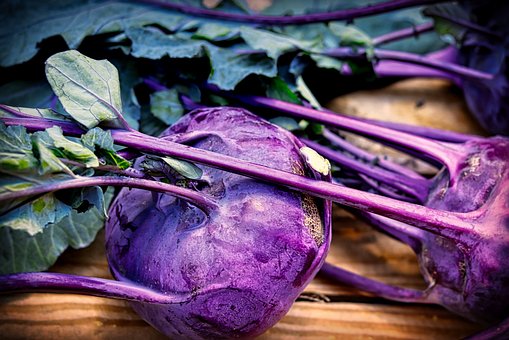The color purple often symbolizes royalty and magic. Lately, purple vegetables have been appearing more frequently. You may have seen different shades of purple in your local grocery store or farmer’s market – from a vibrant purple cauliflower to the darker skins of purple potatoes.
Although these vegetables are brightly colored, are they worth including in your meals on a regular basis? Should you become passionate about naturally hued purple foods?
Purple foods are nothing new. You have probably been eating purple vegetables since childhood. Purple vegetables have been around for a long time. Some vegetables are naturally purple, like eggplant.
Some of the cauliflowers are purple because the farmers bred them to have that color. Humans have been modifying foods for thousands of years. The process is called selective breeding. Unlike genetically modifying foods, it’s a slower process. Farmers grow crops that have desired traits.
Should You Eat More Purple Vegetables and Fruits?
The darker the color of fruits and vegetables, the higher the concentration of antioxidants.
Anthocyanins are a type of pigment that give purple vegetables their color. Anthocyanins is responsible for the vivid violet colors of flowers too. These pigments also act as an antioxidant, meaning they protect the plant from damage caused by sunlight, cold temperatures, and other stressors. Bright colors also attract pollinators, like bees and butterflies.
Antioxidants can also help to prevent and cure many lifestyle diseases such as cancer, diabetes and cardiovascular and neurological diseases.
They can also help to prevent and cure many lifestyle diseases such as cancer, diabetes and cardiovascular and neurological diseases. Mixtures and extracts containing anthocyanins have been used to treat a variety of health conditions. This includes things like hypertension, liver disorders, kidney stones, urinary tract infections, and the common cold.
Purple Vegetables And Fruits You Should Eat
Are you ready to add more purple foods to your diet? Picky eaters might be surprised at how good these colorful veggies and fruits taste.
1. Purple Cabbage
You should be able to find purple cabbage at most grocery stores. This food is a great deal because it has a lot of antioxidants for a low price.
Purple cabbage belongs to the cruciferous vegetable family, which means it has many health benefits, such as fighting cancer, relieving depression, and more.
The leaves on this plant are much thicker than those on a green cabbage, but it tastes similar to cabbage. If a recipe calls for green cabbage, you can easily use purple cabbage instead. Cabbage rolls are a traditional dish that can be made using purple cabbage leaves. The leaves are stuffed with a filling of your choice, rolled up, and then cooked.
2. Purple Onion
The second most affordable and easily found purple vegetable, after purple cabbage, is probably this one. Red onions are purple in color and can be referred to as purple onions.
You can use these onions as a replacement for sweet onion in most recipes. The red onion may add color to your foods. For example, it will turn pickle brine hot pink.
3. Purple Carrots
Did you know that carrots weren’t always orange? Carrots were domesticated in the Afghanistan region around a thousand years ago. At that time, they were purple and yellow. Orange carrots didn’t arrive until the 1500s.
Scientists discovered that purple carrots contain special genes that orange carrots do not, which has made them available again. The genes responsible for their increased resistance to diseases and pests make them more ideal for farming.
The flavor of purple carrots can vary from sweet to peppery. They can range in color from dark violet to reddish purple.
Purple carrots are a beautiful addition to salads and veggie plates — they have bright orange, yellow, or white cores when you cut them. Cooking them has a small impact on the flavor.
Purium’s Carrot Juice PlusTM is a flavorful blend of organic carrots and soluble rice bran. Carrots are packed with nutrients that make them a valuable part of any healthy diet.
4. Purple Cauliflower
More and more stores are stocking purple vegetables as consumers are increasingly demanding purple foods. (You might also see lime green and orange-colored cauliflower.)
Purple cauliflower contains 15% more antioxidants than kale, which is famous for being high in antioxidants. Purple cauliflower can hold its color after cooking better than white cauliflower. People say it also has a milder flavor that is slightly sweeter and nuttier.
You can chop up cauliflower and add it to salads for a bit of extra flavor and crunch. Slaw can easily be turned into a main dish by serving it over quinoa or another favorite whole grain.
5. Purple Kale
Kale is very nutritious. It contains high levels of vitamin C, vitamin A, and vitamin K. These vitamins are essential for normal bone function and blood clotting. Kale contains vitamin B6, which is important for both nervous system and immune system health. Plus minerals iron, manganese, calcium, copper, potassium and magnesium. This food is also rich in lutein and zeaxanthin, which are nutrients crucial for eye health.
Purple kale is a type of kale that has green leaves and purple stems. This vegetable is grown to be eaten, but also to be used as an decoration (many find it stunningly beautiful).
Young, tender purple kale can be used in salads. The leaves that are more mature are better to cook with (steaming is a good method).
Make sure to remove the tough stem and spine from the kale leaves before adding them to the salad. Instead of using a utensil to apply a dressing to the kale, you can use your hands to massage it in, which will make the kale easier to chew.
READ MORE: Top 23 Superfoods
6. Purple Potatoes
Are purple potatoes healthy? If you want to reduce inflammation, you can substitute purple potatoes for white or yellow potatoes. Purple potatoes can also be heart healthy.
Potatoes are rich in vitamin C and contains potassium which aids your heart, muscles and nerves.
Purple potatoes are usually smaller than regular potatoes. It is beneficial to keep the skin on the fruit when consuming it, many nutrients are in the skin. Using purple potatoes for a potato salad is an unexpected twist. This colorful salad will taste just as good as a regular potato salad. You could even add some purple onion or red onion to punch up the color even more.
7. Purple Sweet Potatoes
Sweet potatoes are packed with nutrients like vitamin C, provitamin A, potassium, and B vitamins. The purple sweet potato has anthocyanin antioxidants, which offer an additional benefit.
Research that has been conducted both on animals and in test tubes indicates that purple sweet potatoes may help to reduce inflammation and may also protect against obesity and certain types of cancer, including colon cancer.
You can replace orange-fleshed sweet potatoes with purple sweet potatoes in any recipe.
8. Eggplant
There are many different colors of eggplants, but some of the most common are those with purple skin. While eggplants are not as rich in nutrients as some other foods, they are high in antioxidants and manganese. Manganese is a mineral essential for metabolism and bone health.
The skin of purple eggplants contains a higher concentration of the pigment anthocyanin nasunin, which has been shown in animal and test-tube studies to have anti-inflammatory and heart-protective properties.
9. Redbor Kale
Redbor kale is a very nutritious type of kale. An extract from Redbor kale was found to contain 47 plant compounds, which include kaempferol, quercetin, and p-coumaric acid.
Due to its distinctive color and interesting texture, Redbor kale is often used as a decorative plant to add visual appeal to gardens and planters.
However, it’s also edible and highly nutritious. You can chop it up and use it like you would other leafy greens in many different recipes.
10. Passion Fruit
The tropical vine Passiflora edulis is cultivated for the delicious fruits it produces, called passion fruit. Ripe passion fruits have a soft flesh that is filled with crunchy seeds and is covered by a yellow or purple rind. This fruit is very sweet.
Passion fruit contains an antioxidant called piceatannol, which has been shown to have several health-promoting properties and may be especially beneficial for skin health.
For example, a study that was conducted using test tubes found that piceatannol, which is isolated from passion fruit, protected skin cells from sun damage. Similarly, another study 32 women with dry skin showed that taking 5 mg of piceatannol for 8 weeks increased skin moisture, elasticity, and smoothness.
11. Purple Mangosteen
The Garcinia mangostana tree has been grown since ancient times for the fragrant, purple-toned fruit it produces – the mangosteen. To enjoy a mangosteen, you must first remove the deep purple outer rind. The fruit inside is tangy and slightly sweet.
Mangosteens are rich in fiber and folate, a B vitamin that is vital for many critical processes in your body, like the creation of DNA and red blood cells.
The xanthones in these fruits provides benefits such as reducing inflammation, protecting against damage to the nervous system, and anticancer properties.
12. Purple Asparagus
This vegetable is not only green, but it also comes in white and purple.
The addition of purple asparagus to recipes can improve their nutritional value while also making them more visually appealing. Purple asparagus is a rich source of vitamins, minerals, and plant compounds that can offer various health benefits. It’s an excellent source of anthocyanins.
The asparagus variety that is purple has the highest concentration of rutin. Rutin is a polyphenol plant pigment that may have powerful heart-protective and anticancer properties.
13. Elderberries
The deep purple color of elderberries is linked to their high levels of antioxidants, which are beneficial for supporting the immune system. Some people take elderberry products, such as syrups and capsules, as a natural way to treat colds and the flu.
Human studies have found that taking high-dose elderberry supplements can improve symptoms and shorten the duration of both colds and the flu.
Elderberries contain a high amount of fiber and vitamin C. They are often cooked into jams, jellies, or made into juice, wine, or concentrated syrups.
Kids Immune Shield uses elderberry root which gives a gentle boost to your immune system and helps reduce allergic reactions. Elderberry also helps your body stop the flu and other viruses by inhibiting viral replication.
14. Red Dragon Fruit
Red dragon fruit has a bright, reddish-purple flesh, and its tiny, black, edible seeds are dots on the flesh. The taste of this tropical fruit is often described as mildly sweet and it has a texture similar to a kiwi.
Dragon fruits are healthy because they are low in calories and contain a lot of fiber, vitamin C, and magnesium. They are a good addition to fruit salads and other sweet dishes. Red dragon fruits are also rich in antioxidants, which can help protect the body.
Studies conducted in test tubes show that an extract from red dragon fruit may be able to stop the growth of some types of human cancer cells, including breast cancer, and may cause cancer cell death.
15. Purple Barley
Barley is a grain that comes in several colors, including black, blue, yellow, and purple.
All barley types contain high levels of fiber and minerals, including manganese, iron, magnesium, and selenium. Purple barley is an excellent choice for a nutrient-rich ingredient because it is loaded with anthocyanins as well as other nutrients.
Beta-glucan, which is found in barley, has been linked to many health benefits. reports indicate that beta-glucan has the potential to improve digestive health, lower the risk of heart disease, and bolster immunity.
People who eat a lot of whole grains are less likely to get diseases like diabetes, heart disease, and cancer.
Barley has been served as a food staple throughout history and amazingly is one of the only resources on Earth that can provide the human body with the nutrients it needs from birth through old age. Purium’s Organic Barley Green Juice contains highly assimilable chlorophyll, which is important for total nutrition and also acts as a natural detoxifier.
16. Purple Star Apple
The Chrysophyllum cainito, or purple star apple, is a tree bearing round fruits that turn purple when ripe. The fruits have sweet flesh that secretes a sticky, milky juice. When cut, the fruits show off a radiating star pattern.
The star apple tree has been used by people medicinally throughout history to treat a variety of ailments, including coughs, pain, and diabetes. The fruit, bark, and leaves of the tree have all been used to treat different ailments.
African star apples contain vitamins B1, B2, B3, B6, and E and antioxidants like flavonoids
Star apples are full of antioxidants and may help protect the stomach. Eating African star apples can treat diarrhea and improve your bowel movements.
Conclusion
There are many health benefits to eating purple-pigmented foods, as well as the added bonus of colorful dishes.
Eating foods that are purple, like blackberries, Redbor kale, acai berries, forbidden rice, purple carrots, and elderberries, can help you get a lot of anthocyanin antioxidants and different types of important nutrients.
You should try to incorporate some of the fruits, vegetables, and grains on this list into your next meal or snack to reap the benefits of their health benefits.









